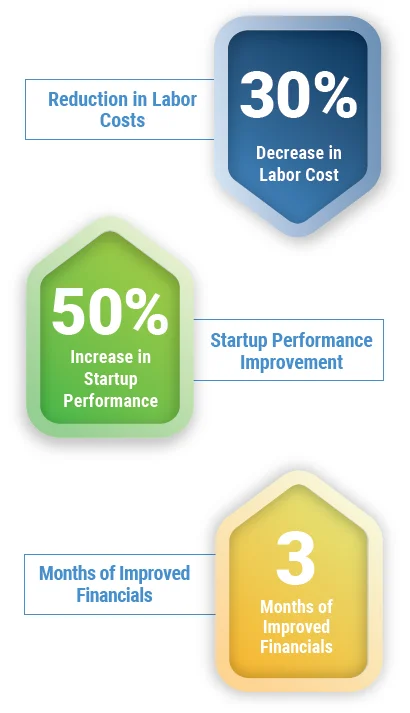

Project Overview
Background
A U.S.-based medical and personal care manufacturer had grown steadily over three decades into a trusted full-service packaging and production partner for major global brands. Its capabilities covered blending and compounding, bottle filling, sachets, tube packaging, and secondary packaging. The company also provided lab services and supported a wide range of industries including healthcare, OTC, cosmetics, animal health, and wound care.
The business had a reputation for technical expertise and quality products, but sustaining efficient operations had become a growing challenge as demand and complexity increased.
Situation
Prior to engaging POWERS, the organization was caught in a cycle of instability. Leadership turnover in operations and maintenance was unusually high, with several managers rotating through the same roles in just a few years. This created an inconsistent approach to scheduling, maintenance, and production execution.

Performance Results

Read the Full Case Study Here
The CEO recognized that the problem wasn’t about finding the right individual, it was about building the right processes that could withstand changes in personnel.
The issues were clear:
- No reliable way to measure whether production was ahead or behind schedule
- Inaccurate production standards that caused both over- and under-production
- Supply chain disruptions tied to unreliable run rates and raw material planning
- Weak handoffs between shifts, leading to machines sitting idle during transitions
- Supervisors not consistently engaged in frontline leadership tasks
- A maintenance department operating almost entirely in a reactive mode, without KPIs or structure
Despite leadership’s efforts, the lack of a systematic approach left operations unpredictable, costly, and frustrating for the workforce.
Analysis
Through an in-depth discovery process, the POWERS team identified multiple areas where performance was breaking down:
- Frontline leadership engagement was minimal, with supervisors spending only 6% of their time actively managing their teams.
- Startup performance lagged at 60%, losing valuable production hours each day.
- Nearly 60% of meetings were ineffective, lacking structure and clear outcomes.
- Maintenance mechanics idled 30% of the time, with no daily or weekly assignments guiding their work.
- Preventive maintenance was absent, leaving the department in constant firefighting mode.
- Production personnel were underutilized many operating below 50% productivity for large portions of the shift.
- Equipment performance issues had become normalized, and additional labor was added rather than addressing root causes.
- Formal communication was inconsistent and ineffective, particularly across shift changes.
The absence of a structured Management Operating System (MOS) meant there was no routine performance review, no mechanism for addressing barriers, and no reliable way to keep leadership aligned with operational goals.
Plan
Our on the ground team developed and implemented a 24-week engagement designed to bring stability and discipline to daily operations. The plan focused on three critical areas:
- Maintenance
- Designed and test-piloted a preventive maintenance program
- Introduced daily and weekly work planning for mechanics
- Assigned technician workloads systematically
- Established meaningful maintenance KPIs
- Standards Refinement
- Updated and validated run rates to reflect actual performance
- Established reasonable labor requirements for production lines
- Launched recurring standards reviews to ensure accuracy
- Improved schedule predictability to support raw material procurement and schedule adherence
- Leadership Development
- Delivered workshops to build frontline leadership skills
- Standardized startup performance routines to reduce daily losses
- Increased use of the Vorne production system for real-time visibility and decision-making
Results
The engagement delivered measurable improvements across cost, performance, and leadership behaviors:
- Labor cost reduction: from 10% to 7% of budget
- Headcount optimization: reduction of ~29 direct labor positions through improved efficiency
- Startup performance: increased from 60% to 90% (a 50% improvement)
- Three consecutive months of record financial improvement following project completion
- Daily and weekly review meetings now use real numbers to quantify performance and generate action items that remove barriers
- Real-time monitoring of production and downtime through Vorne scoreboards improved accountability on the floor
- Schedule accuracy improved significantly, giving supply chain greater confidence in raw material planning and delivery
- Supervisors actively engage in line balancing, adjusting staffing levels in real time to ensure standards reflect actual needs
By embedding new processes and leadership behaviors, the company built a foundation for sustainable improvement. Operations became more predictable, maintenance became proactive, and frontline leaders gained the structure needed to drive performance every shift.




